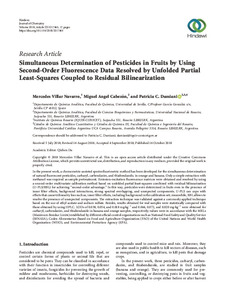Please use this identifier to cite or link to this item:
https://repositorio.uca.edu.ar/handle/123456789/9628| Título: | Simultaneous determination of pesticides in fruits by using second-order fluorescence data resolved by unfolded partial least-squares coupled to residual bilinearization | Autor: | Villar Navarro, Mercedes Cabezón, Miguel Ángel Damiani, Patricia C. |
Palabras clave: | FRUTAS; PESTICIDAS; NARANJA; BANANO; PLATANO | Fecha de publicación: | 2018 | Editorial: | Hindawi | Cita: | Villar Navarro, M., Cabezón, M.N., Damiani, P.C. Simultaneous determination of pesticides in fruits by using second-order fluorescence data resolved by unfolded partial least-squares coupled to residual bilinearization [en línea]. Journal of Chemistry. 2018. doi:10.1155/2018/3217465 Disponoible en: https://repositorio.uca.edu.ar/handle/123456789/9628 | Resumen: | Abstract: In the present work, a chemometric-assisted spectrofluorimetric method has been developed for the simultaneous determination of natural fluorescent pesticides, carbaryl, carbendazim, and thiabendazole, in orange and banana. Only a simple extraction with methanol was required as sample pretreatment. Emission-excitation fluorescence matrices were obtained and resolved by using a second-order multivariate calibration method based on unfolded partial least-squares combined with residual bilinearization (U-PLS/RBL) for achieving “second-order advantage.” In this way, pesticides were determined in fruits even in the presence of inner filter effects, background interactions, strong spectral overlapping, and unexpected components. U-PLS can cope with effects that cause trilinearity loss such as, inner filter effects, including background in the calibration set; meanwhile, RBL allows to resolve the presence of unexpected components. /e extraction technique was validated against a commonly applied technique based on the use of ethyl acetate and sodium sulfate. Besides, results obtained for real samples were statistically compared with those obtained by using HPLC. LODs of 0.038, 0.054, and 0.018 mg·kg−1 and 0.044, 0.072, and 0.020 mg·kg−1 were obtained for carbaryl, carbendazim, and thiabendazole in banana and orange samples, respectively; values were in accordance with the MRLs (Maximum Residue Limits) established by different official control organizations such as National Food Safety and Quality Service (SENASA), Codex Alimentarius (based on Food and Agriculture Organization (FAO) of the United Nations and World Health Organization (WHO), and Environmental Protection Agency (EPA). | URI: | https://repositorio.uca.edu.ar/handle/123456789/9628 | ISSN: | 2090-9063 (impreso) 2090-9071 (online) |
Disciplina: | QUIMICA | DOI: | 10.1155/2018/3217465 | Derechos: | Acceso abierto | Fuente: | Journal of Chemistry. 2018 |
| Appears in Collections: | Artículos |
Files in This Item:
| File | Description | Size | Format | |
|---|---|---|---|---|
| simultaneous-determination-pesticides-fruits.pdf | 5,61 MB | Adobe PDF |  View/Open |
Page view(s)
127
checked on Apr 30, 2024
Download(s)
101
checked on Apr 30, 2024
Google ScholarTM
Check
Altmetric
Altmetric
This item is licensed under a Creative Commons License

